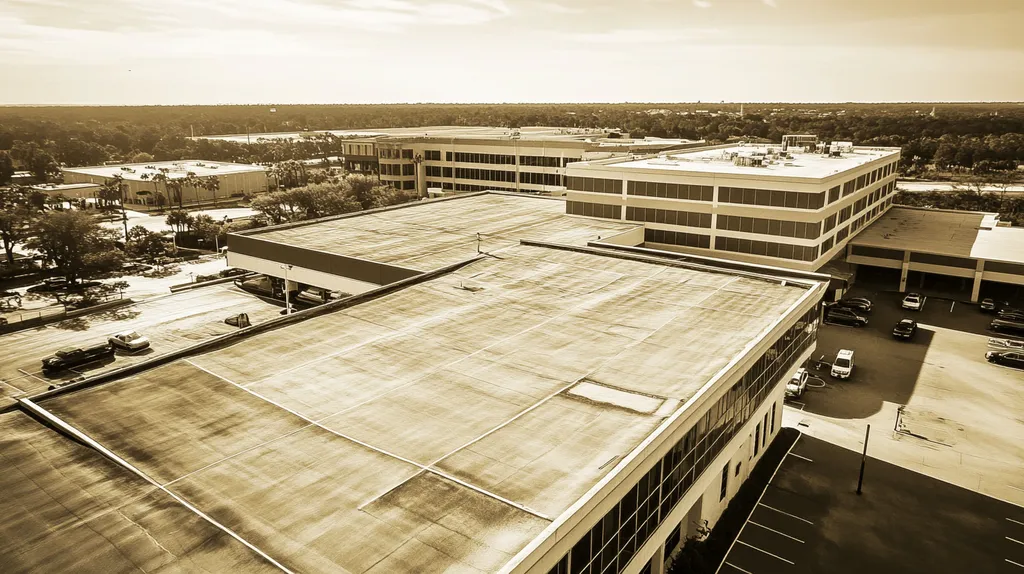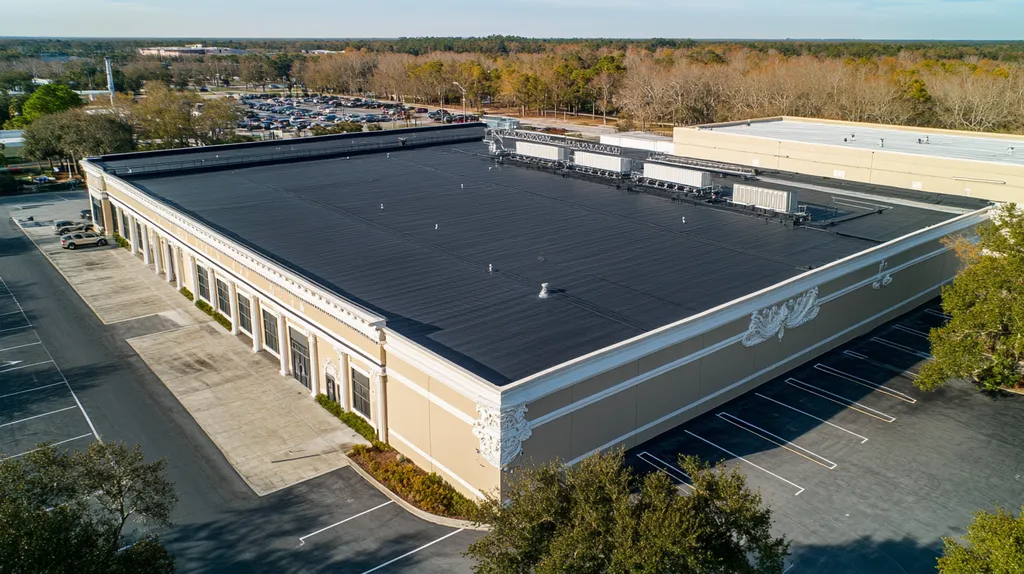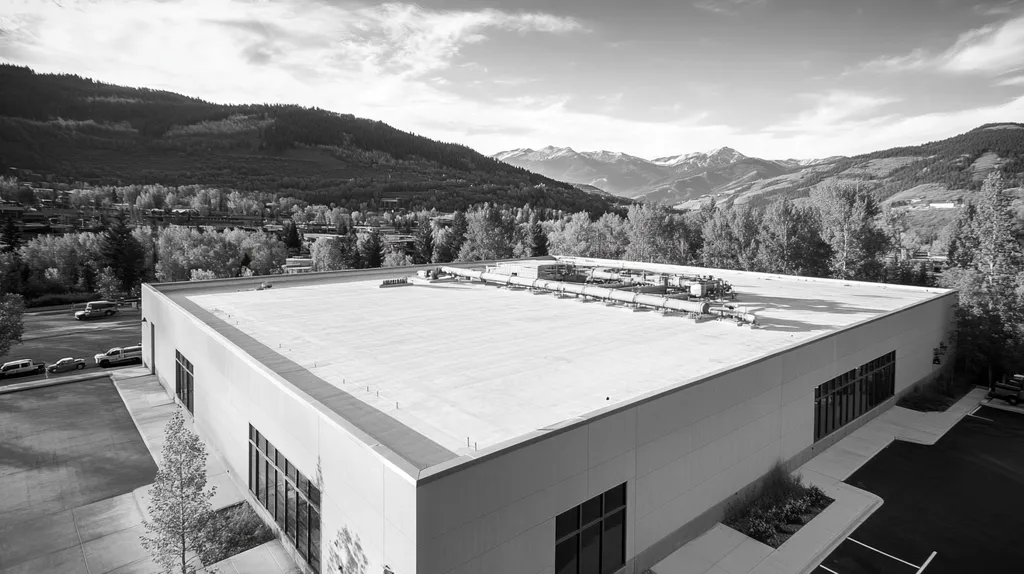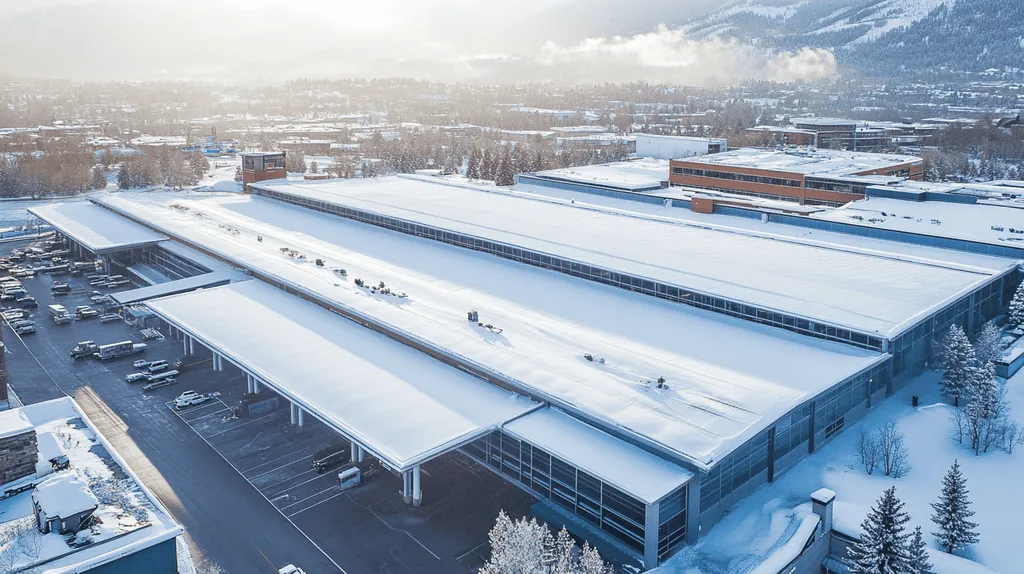Metal commercial roofs protect billions in business assets across America, yet a staggering 40% fail prematurely due to improper preparation and installation. These failures cost property owners millions annually in repairs, energy waste, and structural damage.
The stakes are particularly high for industrial and commercial buildings, where a compromised roof can halt operations and threaten valuable equipment.
This comprehensive guide separates fact from fiction regarding metal roof preparation, empowering facility managers to make informed decisions that maximize their roofing investment’s lifespan and performance.
SECTION 1: COMMON MISCONCEPTIONS
When it comes to selecting a metal roof for commercial properties, the consequences of misunderstandings can be significant. Misguided choices based on widespread misconceptions can lead to expensive leaks, heightened maintenance needs, and even serious safety threats. Many property owners mistakenly treat all metal roofing options as interchangeable, overlook the crucial quality of sourced materials, and disregard the essential role of edge treatments. Addressing these misconceptions is vital for making informed, effective decisions.
Misunderstanding Metal Types and Uses
The reality is that not all metal roofing materials are created equal, and this confusion can yield profound financial and structural consequences. For example, aluminum and steel may appear similar at first glance, but their characteristics are markedly different. Aluminum is lightweight and highly corrosion-resistant, making it a favorite in coastal areas, while steel offers superior strength and durability but usually requires protective coatings to thwart rust.
Often, property owners opt for the cheaper material without considering the specific climate and demands of their building. In coastal regions, for instance, choosing the wrong type can result in swift deterioration, making material selection critically important. By recognizing the unique advantages and disadvantages of each metal, building owners can ensure they choose roofs that promise longevity and resilience against local weather conditions.
Specifications like gauge thickness and weather-resistant coatings are equally crucial in enhancing roof performance. A roofing solution that adheres to industry standards and is tailored to local environmental conditions should never be an afterthought. Investing a little more upfront in high-quality materials can save property owners thousands in repair costs over time.
By understanding the distinctive roles of various metal types, building owners can make choices that not only fit their budgets but also stand up to their unique environmental challenges.
Ignoring Quality Control of Raw Materials
Quality control of raw materials is a critical factor that is often ignored, but it can make or break a roofing project. Many property owners operate under the false assumption that all suppliers maintain the same quality standards, which is simply not the case. Using subpar materials can lead to a plethora of issues, ranging from accelerated wear to complete system failures.
It is essential to prioritize suppliers committed to rigorous quality control processes. For example, steel roofing should meet specifications such as ASTM A792 to ensure durability and resistance to corrosion. Low-grade materials are often more susceptible to rust and degradation, significantly reducing the roof’s lifespan.
Being diligent about evaluating suppliers and assessing their raw material sources can dramatically influence the effectiveness of the roofing system. Regular quality inspections and strict adherence to manufacturing standards should be non-negotiable. Neglecting this crucial step could result in expensive repairs or complete replacements sooner than expected.
Investing in high-quality materials not only boosts the roof’s performance but also helps lower long-term operational costs. Transparency in the quality control processes and material sourcing from suppliers should always be appreciated and sought out.
Overlooking Edge Treatment Importance
Edge treatments are a vital yet often neglected component of metal roofing installation. Many property owners fail to recognize that improper edge treatment can invite moisture intrusion, lead to rusting, and even cause structural failures. Given that roofs endure harsh weather conditions, attention to detail around the edges is especially critical.
For instance, in windy environments, edges that are inadequately secured can cause roof panels to lift or, in worst-case scenarios, result in total roofing system failure. This not only threatens the overall structural integrity of the building but also leads to expensive repairs down the line. Effective edge treatment is essential not only for securing the roofing system but also for achieving proper water drainage.
Additionally, including flashing and other protective elements during installation can significantly reduce the risk of water pooling. Investing in the right edge treatment can greatly prolong the life of the roof and enhance its overall functionality. Building owners are encouraged to partner with qualified professionals who understand the importance of these critical details.
In conclusion, neglecting edge treatments can end up costing building owners considerably more in repairs than the initial investment in a quality roofing system. It is imperative to treat every part of the roofing process, especially the edges, with the careful consideration they warrant.
SECTION 2: PRACTICAL IMPLICATIONS
The preparation of a metal commercial roof isn’t just another routine chore; it’s the cornerstone of a building’s longevity and safety. Inadequate preparation can lead to severe issues, including costly repairs and a significantly reduced lifespan of the roofing system. Astonishingly, poorly prepared roofs can lose up to 50% of their expected lifespan, putting both property and investment at risk. This section dives into the crucial implications of roof preparation on durability, weather resistance, and energy efficiency.
Impact on Roof Durability and Lifespan
Durability is critical for roofing, particularly for metal roofs that confront the elements daily. Without thorough preparation, the risk of corrosion and rust greatly escalates. Applying a protective coating or primer is essential for enhancing longevity, as it establishes a formidable barrier against environmental stressors.
Moreover, the proper installation of underlayers and insulation strengthens the roof’s structural integrity. Roofs that undergo meticulous preparation can last 30 years or more, while neglected roofs might need replacement in as little as 15 years. That is a drastic difference driven by how well the system is readied from the start.
Regular inspections, alongside conscientious initial treatments, contribute to fewer repairs and slower degradation. Therefore, investing in adequate preparation is not merely wise; it cultivates long-term savings and peace of mind for building owners. A well-prepared roof endures through time and weather, ensuring reliable protection.
Effects on Weather Resistance and Safety
Weather resistance directly correlates with the safety and security of a building’s environment. Metal roofs that lack proper preparation may fall prey to leaks and water damage, especially during severe weather. The expenses associated with water damage repairs frequently far exceed the perceived initial savings from cutting corners.
Additionally, sealing all seams and fasteners thoroughly during preparation is essential for preventing wind uplift, a frequent cause of roof failures. A well-prepared roof not only shields against rain and snow but also reinforces overall safety.
In areas vulnerable to extreme weather, preparation becomes paramount. For instance, roofs designed with effective drainage are less likely to suffer from ice dam formations, which can spell disaster for structural integrity. By ensuring a robust roof preparation, building owners can mitigate risks and keep both personnel and property safe.
Consequences for Energy Efficiency and Maintenance
Energy efficiency is a growing concern for commercial buildings, influencing both operational expenses and environmental sustainability. A surface improperly prepared for a metal roof can contribute to unwanted heat gain due to insufficient insulation and inadequate reflective properties.
Incorporating reflective coatings during the preparation phase can lead to substantial reductions in cooling costs. Research indicates that businesses can save up to 20% on energy bills with properly treated roofing systems. This translates not just to lower expenses, but also to a smaller carbon footprint.
Furthermore, robust maintenance practices stem from effective preparation. A roof constructed with high-quality materials requires less frequent upkeep and fewer repairs. Less maintenance equates to fewer disruptions in daily building operations.
The return on investment (ROI) for building owners skyrockets when improved energy efficiency results in diminished operational costs. This balance between short-term investments and long-term savings makes proper preparation an essential priority for smart property management.
SECTION 3: COST OF MISINFORMATION
Misinformation about metal roofs can have severe financial consequences for property owners. A pervasive myth is that metal roofs need to be replaced after just 20 years, leading to unneeded expenses. In reality, many metal roofs can last 50 years or even longer with the right maintenance. This misunderstanding can lead to decisions that harm budgets and overall financial health.
Financial Losses from Premature Replacement
Relying on outdated beliefs can result in premature roof replacement, resulting in significant financial setbacks. A well-maintained metal roof may only need minor repairs after two decades, yet some property owners opt for complete replacement instead. This mistake can easily lead to costs soaring into the tens of thousands, violating the budget.
These funds, wasted on unnecessary replacements, could have been directed toward essential facility needs or upgrades. Moreover, expenditures from hiring contractors, purchasing new materials, and managing disposal fees only compound the financial strain. Ultimately, such decisions threaten the economic viability of the entire project.
By understanding the actual lifespan of their roofs, property owners can allocate their maintenance budgets more wisely. Keeping stakeholders informed about accurate lifespan information can lead to better investment choices in building upkeep.
For instance, conducting regular inspections allows owners to identify genuine repair needs early. This proactive approach can prioritize maintenance, ensuring valuable resources aren’t squandered on costly, premature replacements.
Increased Maintenance and Repair Costs
Misinformation doesn’t stop at replacement decisions; it also affects maintenance and repair expenses. Property owners who believe myths may engage in unnecessary repairs that do more harm than good. For example, assuming a metal roof is rusting without proper evidence can lead to unnecessary treatments that waste time and money.
Such misguided fixes can inadvertently exacerbate existing issues, further damaging the roofing system and leading to greater expenses over time. Trusting accurate assessments helps ensure that maintenance targets real problems, optimizing resource utilization.
A proactive maintenance strategy informed by accurate knowledge can significantly extend the lifespan of metal roofs. Regular inspections enable early problem detection, significantly lowering repair costs.
In light of this, emphasizing factual information about metal roofs is critical. An informed approach not only saves money in the short term but also yields long-lasting benefits for facility management and operational budgets.
Energy Efficiency and Utility Bill Impacts
Lastly, misinformation can dramatically affect a facility’s energy efficiency and utility costs. Misconceptions about metal roofs being less energy-efficient lead to poor insulation choices and reflective coating decisions.
In fact, many metal roofs can incorporate energy-efficient technologies that substantially lower cooling costs. Facilities equipped with accurate information often see reduced utility bills as a direct result of informed upgrades.
For example, selecting the right reflective coating can lower heat gain during summer, translating into significant energy savings. Therefore, investing in accurate information and the right solutions pays off immensely in the long run.
Additonally, energy-efficient buildings can qualify for tax incentives and rebates. Embracing verified energy-saving measures allows facility managers to maximize financial benefits while optimizing their properties.
SECTION 4: REALITY CHECK
Investing in metal roofs can yield significant benefits, but the stakes are high when it comes to material selection and processes. A compromised roof can lead to devastating leaks, costly structural damage, and even safety hazards for occupants. Building owners need to be equipped with a solid understanding of metal material choices, processing techniques, and essential coatings to ensure their roofs perform optimally and withstand the test of time.
Accurate Selection of Metal Materials
The selection of metal for a commercial roof is critical—it directly impacts durability and performance. Common choices like stainless steel, aluminum, and galvanized steel each bring unique benefits and drawbacks. For instance, stainless steel excels in corrosion resistance, making it ideal for coastal regions, while aluminum is lightweight and resistant to rust. On the other hand, galvanized steel, treated with a zinc coating, offers reasonable durability at a lower cost but may require regular maintenance to prevent corrosion over time.
When choosing materials, building owners must weigh local climate conditions, elevation, and the intended use of the roof. Failing to select appropriate materials can result in critical issues such as rust, punctures, or thermal expansion-related problems. Ultimately, investing in high-quality materials not only pays off through reduced repair costs but also ensures a longer lifespan for the roof. Property owners should also seek solid warranties from manufacturers to safeguard their investment.
Proper Processing and Molding Techniques
The reliability of metal roofing is significantly influenced by proper manufacturing processes, which include cutting, bending, and shaping metals to endure environmental stressors. Low-quality processing can create weak points that expose roofs to leaks and damage. For example, poor seam welding may lead to disengagement over time, allowing water to infiltrate.
Employing modern molding techniques can enhance the integrity of roofing panels, greatly reducing the risk of deformation. Consistent quality control during production is essential to achieve enduring durability and performance. Property owners must avoid settling for generic products; customization tailored to specific requirements often delivers superior results. This approach not only enhances visual appeal but also ensures that the roof meets precise load and weather parameters.
Importance of Coating and Pretreatment
Coatings and pretreatments are vital for ensuring that metal roofs deliver long-lasting performance. These protective layers work to prevent corrosion, reflect sunlight, and guard against dirt and biological build-up. Skipping proper coating can drastically shorten a roof’s lifespan and escalate repair costs, as exposure to UV rays without protective measures can weaken materials and lead to fading.
Property managers should prioritize high-quality coatings, such as Kynar or Hylar, which are specially formulated to resist fading and chalking. These finishes not only enhance the roof’s visual appeal but also provide excellent weather resistance. Moreover, pretreatment processes, such as thorough cleaning and priming before application, are essential for achieving optimal adhesion and extending a roof’s life. Neglecting these crucial steps can result in premature failure of the protective layers.
SECTION 5: EVIDENCE-BASED ALTERNATIVES
The integrity of a metal roof is directly influenced by its installation techniques, making it vital for long-term durability. A roof that is not installed properly can lead to costly leaks, extensive structural damage, and energy inefficiencies. Alarming statistics reveal that improper installation accounts for over 50% of roofing failures. This section focuses on essential practices for installation, preventative measures, and advanced techniques for waterproofing and sealing, all aimed at ensuring peak performance for metal commercial roofs.
Correct Installation of Underlayment and Panels
The underlayment is a crucial barrier, acting as a second line of protection against moisture intrusion. It needs to be installed correctly to minimize the risk of water accumulation and should be compatible with the metal roofing material to maximize effectiveness. Ensuring the underlayment covers all areas—including edges and overlaps—can safeguard against leaks (source: Xinbo).
Precision is key when installing metal panels. Proper alignment and accounting for thermal expansion help the panels move freely as temperatures fluctuate. Manufacturers typically provide specific installation guidelines, essential for avoiding complications that could arise later.
The selection of robust, corrosion-resistant fasteners is also critical to a roof’s integrity. These fasteners must be appropriately spaced and positioned per the manufacturer’s recommendations to reinforce the overall structure. Property owners should work with contractors who strictly adhere to these fastener guidelines.
Minimizing gaps between panels is equally important. Even minor spaces risk water pooling, which can be damaging over time. Ensuring a snug fit between panels mitigates this risk, leading to a more reliable roofing installation.
Proper Securing of Panels and Ridge Caps
Correctly securing metal panels is essential to stave off wind uplift and inhibit moisture penetration. Ridge caps, which cover the roof’s peak, demand special attention during installation. If not adequately secured, ridge caps can undermine the system’s ability to drain water effectively.
Choosing the right sealant plays a significant role in fortifying the security of both ridge caps and panel seams. High-quality sealants are engineered to withstand various elements while forming a durable, waterproof barrier. Selecting reputable products with proven track records can provide building owners with added reassurance.
Regular inspections post-installation are vital to detect any loose or corroded fasteners early. Adopting this proactive stance on maintenance can safeguard panel integrity. Moreover, ensuring that panels receive support at recommended intervals lessens the risks posed by adverse weather conditions.
A carefully executed installation of panels and ridge caps creates a unified roofing system poised to endure harsh elements. This approach not only enhances the facility’s protection but also leads to significant long-term savings for property owners.
Best Practices for Waterproofing and Sealing
Waterproofing and sealing are crucial for extending the life of metal roofs. Neglecting this critical aspect can lead to severe issues like rust and leaks. Implementing a high-quality waterproofing membrane is a time-tested solution that effectively secures roofs against moisture.
Sealants should be applied during the initial installation and after any repairs to ensure all seams and joints are tightly sealed. This prevents unwanted water intrusion and is best achieved with sealants specifically formulated for metal roofing, which offer superior adhesion and longevity.
The design and location of the roof significantly influence the choice of sealing products. In areas with high moisture, additional layers of protection may be essential. Building owners should consult roofing professionals to determine the most effective sealing solutions tailored to their unique environments.
Annual inspections should include assessments of the waterproofing elements’ integrity. Promptly addressing any visible wear or damage can extend the roof’s useful lifespan while providing crucial protection against the elements. This preventive approach makes a world of difference between a roof that thrives and one that falls prey to environmental challenges.
SECTION 6: TEST AND VERIFY
Ensuring the integrity of a metal commercial roof is not just a formality; it is crucial for protecting significant investments and avoiding expensive repairs. Alarmingly, nearly 30% of commercial roof failures stem from improper installation and insufficient inspections. Therefore, building owners and facility managers must prioritize rigorous testing and verification protocols to safeguard their facilities and maximize roof performance. This section outlines critical inspection processes essential for a successful metal roofing project.
Inspecting the Roof Deck and Structure
The roof deck and underlying structure are the backbone of metal roofing systems. Prior to installation, it is vital to conduct a thorough inspection of these elements. Identifying any signs of rot, corrosion, or inadequate support is essential, as a compromised deck can precipitate future leaks or even roof collapse.
For example, water damage on the deck could jeopardize the entire roofing system’s integrity. Inspectors must also verify that the deck is level and securely fastened, as this ensures proper installation of the panels. This foundational step is vital for achieving long-lasting performance.
Post-installation, periodic inspections are equally important. Changes in environmental conditions or unexpected weather events can cause new issues, making ongoing vigilance crucial. Regular assessments can significantly enhance the roof’s ability to withstand the elements, ultimately extending its lifespan.
In summary, a thorough inspection of the roof deck and structural integrity is a critical investment. It lays the groundwork for maintaining roof performance and, by extension, protects the valuable assets beneath.
Verifying Panel Alignment and Fastening
Panel alignment is fundamental to ensuring a metal roof functions effectively. Misaligned panels create gaps that can allow water intrusion, leading to costly repairs down the line. Each panel should be installed according to the manufacturer’s specifications, ensuring proper spacing and overlapping.
Securing each panel with the correct fasteners is equally essential. Utilizing inappropriate fasteners or neglecting them altogether can jeopardize the roofing system. A meticulous check should be conducted during and after installation to confirm that all fasteners are correctly installed and torqued according to specifications.
Furthermore, property owners should request documentation that confirms all panels have been installed correctly. This verification provides a safeguard for future warranty claims and protects against disputes with contractors. Maintaining comprehensive records fosters accountability and provides peace of mind.
In conclusion, verifying panel alignment and proper fastening prevents leaks while upholding the manufacturer’s warranty. Taking a proactive approach during this phase can yield substantial time and cost savings in the long run.
Final Inspection and Cleaning Procedures
Conducting a final inspection is the concluding step before a metal roof is certified complete. This comprehensive process should evaluate both the visual quality and functional performance of the roof. Inspectors must be vigilant for any defects, uneven surfaces, or components that were improperly installed.
Cleaning the roof after installation is also an essential task. Removing debris, tools, and leftover materials not only improves aesthetic appeal but also mitigates potential problems. Accumulated debris can trap moisture, leading to corrosion or mold growth on metal surfaces.
Moreover, an effective final inspection checklist should confirm that all flashing, seals, and joints are correctly secured. Each joint must be scrutinized for potential failure points, as these areas are often susceptible to leaks. Proper sealing methods are crucial for ensuring long-term roof performance.
Ultimately, a thorough final inspection, coupled with diligent cleaning, reinforces the durability of a metal roof. It serves as the last line of defense against future issues and should be executed meticulously to ensure adherence to all installation standards.
The Bottom Line
With over 40% of metal commercial roofs failing prematurely, the stakes for proper preparation couldn’t be higher.
The evidence is clear: meticulous attention to material selection, installation protocols, and ongoing maintenance can extend a metal roof’s lifespan from 15 to 50+ years while delivering substantial energy savings.
Building owners who rely on proven best practices rather than outdated misconceptions protect not just their roofing investment, but their entire facility’s structural integrity and operational continuity.
The future of commercial roofing demands an evidence-based approach, combining rigorous material standards with systematic quality control and regular inspection protocols.
By separating fact from fiction, facility managers can make informed decisions that maximize protection while minimizing long-term costs.
FREQUENTLY ASKED QUESTIONS
Q. What are common misconceptions about commercial roofs?
A. Many property owners assume all metal materials are the same, which isn’t true. Each material has unique properties that affect durability and performance. Choosing the wrong type can lead to expensive repairs and premature roof failures.
Q. How does preparation affect the lifespan of an industrial roof?
A. Proper preparation significantly enhances the durability and lifespan of a commercial roof. Inadequate preparation can lead to corrosion and leaks, cutting the roof’s longevity in half. Investing time and resources into the preparation pays off in the long run.
Q. What financial risks arise from misinformation about metal roofs?
A. Believing that metal roofs require frequent replacements can result in unnecessary costs. Understanding the actual lifespan could save owners tens of thousands in premature replacements or excessive repairs, allowing better budget management and resource allocation.
Q. Why is material selection critical for metal commercial roofs?
A. The choice of metal directly influences a roof’s durability and performance. Different metals like stainless steel and aluminum serve various climates and applications. Correct selection prevents issues like rust and punctures, ensuring longer-lasting protection.
Q. How important is proper installation for metal roofing?
A. Installation is critical; over 50% of roofing failures stem from improper methods. Correctly securing panels and following guidelines ensure waterproofing and structural integrity, reducing leaks and damage. Quality installation greatly contributes to long-term roofing success.
Q. What inspection processes are crucial for a metal roof?
A. Inspecting the roof deck, panel alignment, and securing fasteners are essential processes. Identifying issues early can prevent costly repairs and maintain the roof’s integrity. Regular inspections ensure the roof withstands environmental stressors over time.
Q. What maintenance practices should be adopted for industrial roofs?
A. Regular inspections and immediate repairs are vital for maintaining an industrial roof. Keeping gutters clear and checking seams for leaks prevent bigger problems. Implementing a routine maintenance schedule ensures your roof remains effective and extends its lifespan.











